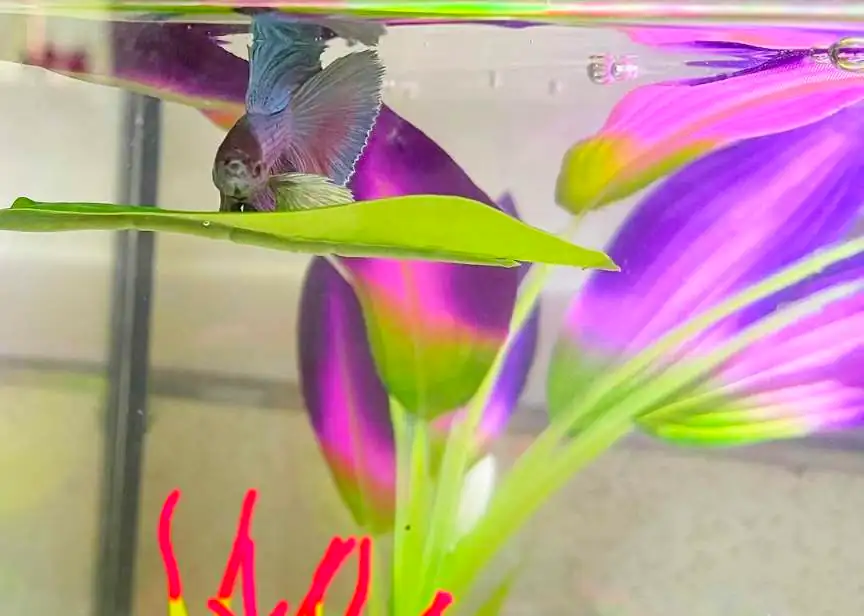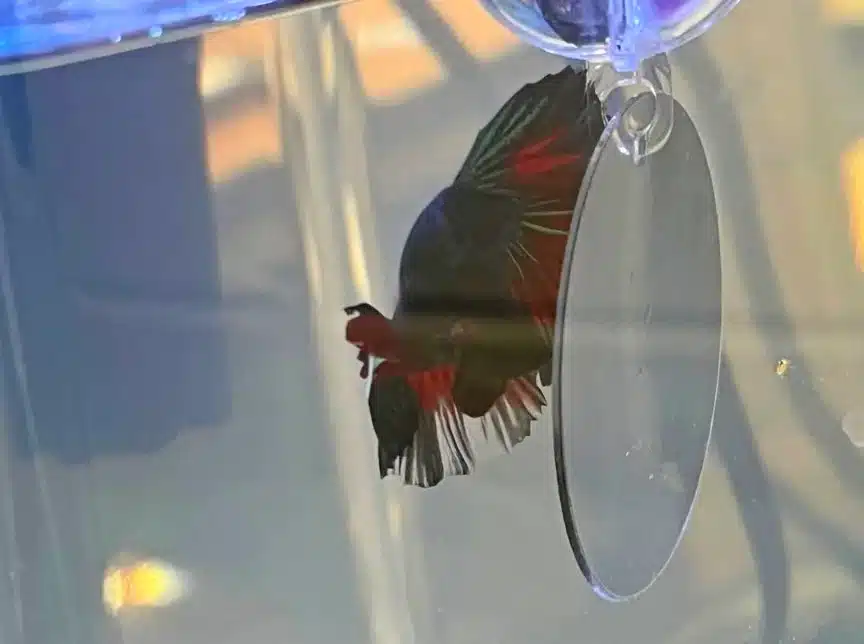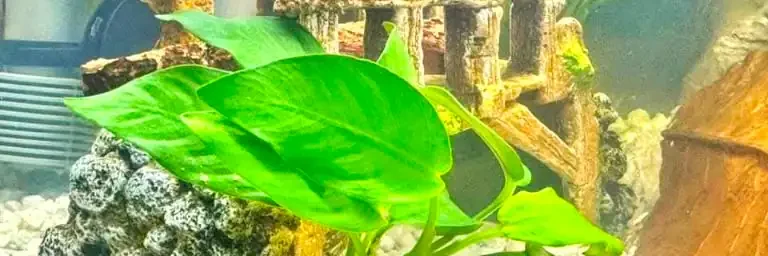Top 10 Betta Fish Toys Loved by Real Owners
Betta fish aren’t just pretty to look at. They’re smart, curious and full of personality. While most betta owners focus primarily on water quality and diet, that’s not enough. Just like dogs or cats, betta fish need fun and stimulation to stay happy. If your betta remains unusually inactive or seems bored despite proper care, why not try adding some toys?

Keep in mind, not every toy works for every betta. It requires some research and experimentation with toys to find the best fit for your fish. Based on feedback from real betta owners and our own testing, here are top 10 toys that betta experts highly recommend.
Why Toys and Enrichment Matter
You might wonder, do fish need toys? The answer is yes! Not plastic balls or squeaky toys like dogs, but items that make their world interesting.
Below are some common reasons why betta enthusiasts should add toys to their tanks.
Prevents Boredom and Stress
Bettas can get bored in a dull tank. A boring setup often leads to lethargy, fin-nipping or aggressive behavior. Giving them things to explore helps reduce stress and keeps them active and happy.
Boosts Physical Health
When your betta swims around obstacles, explores tunnel, or rests in a leafy hammock, he is exercising naturally. This helps build muscle and keeps his fins strong and flowing.
Gives Mental Stimulation
Believe it or not, bettas are smart little fish. They like to figure things out like finding a new hiding place or weaving through a tunnel. It keeps their brain active and mimics how they behave in the wild.
Backed by Science
Fish researchers and aquatic vets agree that adding variety and hiding places in tanks improves fish health. Studies on fish behavior show that enriched environments such as tanks with live plants, decor, and places to explore make fish less stressed and more active.
So, yes! Your betta does need toys. Things like leaf hammocks, tunnels, floating logs, or even mirrors used can make their world more interesting.
Types of Safe Betta Fish Toys
1. Leaf Hammocks
Leaf hammocks are placed in betta tanks to provide a resting spot, typically sticking to the side of the tank near the surface using a suction cup. However, your betta may not always use them. In our experience, when we have broad-leaved plants like Anubias in the tank, most of the bettas we’ve kept tend to ignore the hammock and prefer resting on the plant leaves instead. Only a few of them ever adapted to using the hammock.

So, what should you do? If your betta doesn’t rest despite having broad-leaved plants in the tank, you might consider adding leaf hammocks. Otherwise, it’s perfectly fine to go without one. Leaf hammocks can also be a good option if your betta enjoys chilling close to the air.
2. Floating Logs
Floating logs are one of the most popular toys among betta fish owners. These circular, ring-like structures can be attached with suction cups to keep them in place. Bettas love lounging inside or underneath these logs, especially near the surface. It can offer both lounging and hiding opportunities.
Male bettas often build bubble nests at the water’s surface. The underside of a floating log can become a preferred spot for this, as it provides shelter and stability for the bubbles. Among floating logs, the Zoo Med Floating Betta Log is my favorite.
However, your betta may ignore the floating log depending on the tank setup. If there is a surface movement from the filter, chances are that bettas don’t use it.
3. Natural Hideouts (Wood, Rocks & Tunnels)
Exploring and hiding are the natural instincts of betta fish, which they exhibit in the wild. In tanks, performing these activities keeps them stimulated and makes happy. Our current betta spends hours tucked away behind the decor.
Wood and Rocks
Natural wood and rocks create hideouts and exploration zones. Flat pieces of wood provide bettas with a cool resting spot, either on top or underneath. Securing a flat piece of wood with suction cups is a creative idea. It gives your betta a fun spot to hop on.
Tunnels
Another way to provide a hiding spot for your betta is by creating a simple DIY tunnel using the cap from a mouthwash bottle. Cut a hole in the closed end and anchor it to a decorative stone with a fishing line. Your betta will hide and swim through it, creating a safe and stress-free zone for him to relax.

In addition to this, we’ve also experimented with ceramic caves or ceramic moon stones with holes. They offer a stylish and functional addition to the tank, and bettas love swimming in and out of them.
4. Mirrors
Mirrors are one of the favorite betta fish toys among many betta hobbyists. They stimulate the natural habit of gill flaring. In the wild, when a betta sees another betta, he flares his gills to appear larger and compete with his rival. A fun fact is that bettas don’t recognize their reflection. They usually perceive the image in the mirror as another rival.

According to anecdotal experiences, gill flaring is a form of exercise that can help maintain digestive health. However, mirrors should be used in moderation. Never leave a mirror in the tank permanently, as prolonged exposure can trigger aggression and stress. We use them sparingly, 10 minutes a day or less.
5. Ping Pong Balls & Floating Toys
Ping pong balls are simple and affordable betta toys commonly used in betta tanks for enrichment. They’re usually made from non-toxic, aquarium-safe plastic and float on water surface. Since bettas are surface breathers, they intend to interact playfully with objects floating at the top. That’s why ping pong balls are our favorite addition to a betta tank.

We drop the balls in for 10-15 minutes, and my betta enjoys pushing and chasing them. Some find this highly stimulating and engaging while others may not be interested, since each fish has its own personality.
Besides ping pong balls, sinking smooth marbles or plastic balls can also be unique additions to betta toys. Only add them if you don’t have gravel in your tank. Bettas push them around the bottom, offering interactive fun.
6. Plastic Rings or Hoops
A plastic ring or hoop is rarely used betta toy. You can DIY one using a shower curtain ring or plastic hoop to train your betta to jump through it. You can call it a fun trick and exercise activity.
7. Marimo Moss Balls
Marimo Moss balls, a widely used natural betta toy, not only serve as toys but also function as natural cleaners. These spherical balls are actually a type of algae that helps reduce toxins like ammonia, nitrate and nitrite in the tank.
In addition to their benefits, Marimo Moss balls are fun for bettas to rest on or nudge around. However, they should be appropriately quarantined and cleaned before being added to the tank.
These balls require minimal maintenance. To maintain their shape and health, gently rinse and roll them in siphoned tank water weekly and occasionally refresh them in the fridge.
8. Laser Pointer
Laser light is a debated topic when it comes to betta toys. While it can provide short-term stimulation, it also comes with certain risks. A laser pointer must be used carefully and responsibly. Keep the following points in mind when using one.
- Use a weak, pet-safe laser (<5mW).
- Avoid pointing it in or near your fish eyes.
- Limit sessions to just a few minutes.
- Use it occasionally as a treat or special activity, not a daily routine.
Bettas often follow the laser dot, seeing it as prey and may chase or flare at it. This can encourage their natural hunting instincts and promote swimming activity.
9. Betta Beads (Orbeez) Ball Pit
Some owners place a bowl filled with soft and water-safe betta beads like Orbeez in the tank, creating a ball pit for their betta to explore. The squishy texture can intrigue the fish, though supervision is recommended to ensure no ingestion occurs.
10. Air Stones & Bubble Pumps
Air stones and bubble pumps are highly recommended as betta toys, even though they’re often used as decoration items. They mimic the characteristics of slow-moving water found in the natural habitats of betta fish.
Low-flow bubblers can be especially beneficial, creating gentle stimulation and improving oxygen levels. Some bettas love laying against sponge filters, which can function as low-flow bubblers. The movement and shimmer of these bubbles catch their attention and encourage exploration.
Bettas may also swim against the gentle flow of these bubbles, which helps keep them active and engaged. However, ensure the bubbles aren’t too strong, as bettas don’t do well in rough or fast-moving water.
Low-cost Betta Toys Ideas
DIY Ball Pit
If you are looking for economical betta toys, craft DIY toys from homemade items. We have tested placing a bowl filled with soft, water-safe beads like Orbeez in the tank, which creates a ball pit for bettas to explore. Their squishy texture can intrigue the fish; however, supervision is recommended to avoid ingestion.
Flare Pens
You can craft DIY flare pens using cardboard cutouts to stimulate bettas for their rivals. These pens can be used for short, controlled flaring sessions to provide enrichment without causing stress.
Drawing on the Glass
One of our most experimented low-cost ideas is to draw a line, shape, drawing, or pattern on tank glass with a dry-erase marker. Our betta loves it and flares at the drawing. It captures the betta’s attention and gives it something new to focus on.
You can use this technique for the bettas who don’t react to mirrors. Just don’t leave it on too long to avoid smudging or residue. Try shapes or lines in contrasting colors—you might be surprised by your betta’s reaction.
Things to Avoid or Be Cautious About
- Overuse of Mirrors: Excessive use of mirrors leads to continuous flaring, which can cause stress and gill damage.
- Toys with Rough Edges: Avoid any toy that may tear delicate betta fins.
- Overstimulating Toys: Not every betta enjoys toys. Don’t force interaction. Let your fish show interest naturally.
- Painted Decorations: Some floating betta logs may have paint that chips over time and degrade water quality. Always check the materials used.
- Over-flaring: While flaring is natural and healthy in moderation, too much can stress or even harm your betta. Don’t let your fish see their reflection constantly.
- Unsafe Toys: Avoid sharp plastic or metal toys that could tear fins or leach harmful substances.
Preparing Toys for Your Betta Tank
Cleaning and prepping everything properly is important before you drop that cute little cave or leaf hammock into your betta’s tank. New items, whether they are decor, toys, or even plants, can sometimes carry dust, chemicals or harmful bacteria that might upset your fish health.
Always start by rinsing new items under cool and running tap water. This helps remove any surface dust or factory residue.
It’s far better to sanitize toys by boiling them for things like ceramic, rocks or hard plastic. Boil them for 10–15 minutes to kill any hidden bacteria or parasites.
Or sanitize by soaking for delicate or non-boilable items. Soak them in dechlorinated water for 24 hours. Change the water a couple of times to flush out anything harmful.
Final Thoughts
We have provided you with numerous options for betta fish toys but you should not adopt them all at once. There’s no ‘one size fits all’ toy for bettas. The best way to find out what works? What works for one fish might not work for another, so observe and adapt.
Observe your betta’s behavior, try different items and mix things up. Whether it’s a mirror, leaf hammock, floating log, a laser light or your finger at the glass, enrichment keeps your betta healthy, happy, and bursting with personality. Rotate decors or toys occasionally to keep things fresh and exciting.
Let your betta show you what they like and have fun bonding with your little aquatic friend.




